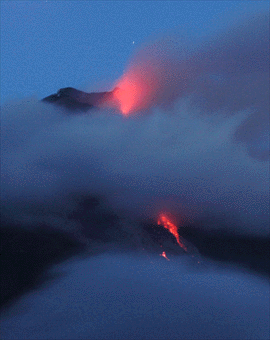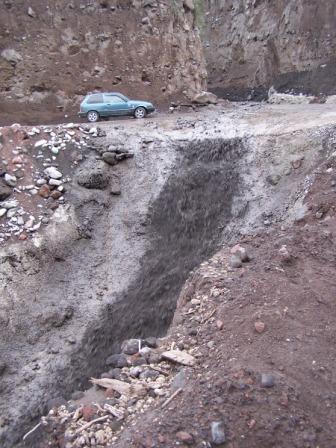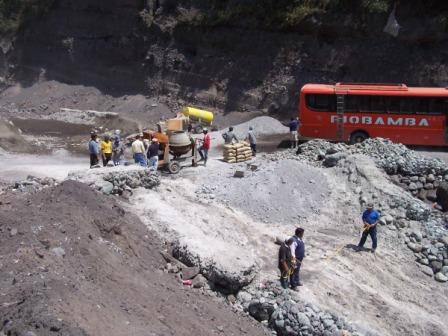|
A HUMBLE HOMAGE TO |
|
MAMA TUNGURAHUA & HER OFFSPRING |
|
By Kashyapa A. S. Yapa |
 |
Mama Tungurahua is angry. In fact, she's fuming; literally, spewing fire. |
|
Courtsey: El Diario Hoy
|
|
She is a regular smoker. She has been, ever since I saw her in 1996 and even since long before. Those occasional belches of smoke, people could handle. Nobody bothered too much about having to wipe out a little bit of black ash off the windscreen or off the front porch in the morning. Truly, it reminded your being a part of a living environment. |
|
It had become pretty much a ritual in Central Andes of Ecuador to peek out of your window to see whether the 'mama' is smoking today. |
|
Then, in 1999, all of a sudden, she got mad; really mad. She just blew up; sending out dark grainy clouds kilometers up into the sky and all around the country, raining incandescent pebbles over her faithful neighborly offspring, and pouring streams of hot lava down the canyons all the way to the river. Who provoked her? Maybe, the ex-President Abdala (Bucaram), with his foul mouth, his 'belly-dancing' on stage, and his blue-collar style outright robbing of meager government resources? Maybe it was Jamil (Mahuad), with his shameless white-collar stealing of poor man's savings through his banker cronies? May be all of us should share the blame, for letting our beloved Sucre succumb to a despicable death against the almighty dollar, through sheer ignorance and apathy. |
|
Well, her neighbors neither had the time nor the mind
to analyze whom to blame. They scurried up and down trying to escape the
wrath of mama Tungurahua, abandoning hundreds of hectares of apple orchards,
cornfields and potato farms and thousands of heads of cattle, pigs and
chicken.
|
 |
|
Courtsey: El Diario Hoy
|
|
Politicos rushed in, offering loads and loads of help, mostly in words. And, were much eager to rush out, the moment the hot-air-blowing 'Mama' cooled down. A few months later, the refugees, those who dare and those who were bare, trudged back to what was left of their homes. A grim picture awaited them. Many roofs had collapsed with the weight of the ash. The fruit trees, those that managed to survive, had barely the branches. No corn, no potatoes, not even grass for the animals. Well, they had no animals anyway. Most villages had no electricity or pipe-borne water. |
|
|
The main thoroughfare below the mountain, the highway
linking Riobamba with Baños, had been cut open by no less than
fourteen, deep, chasms.
|
|
It was a hopeless situation, almost. Yes, almost, because they knew, out of experience, that though mama Tungurahua could take everything away in an instant, she's known to give back all that; and more. So, armed with their bare hands and backed up by heaps of faith on the generosity of the 'Mama', they began reconstructing their lives from scratch. By the time the indigenous political party, Pachakutik, assumed power in the Provincial Government of Chimborazo, in the month of January 2005, the affected communities were still struggling to re-establish the bare minimum of essential services. Water and electricity services functioned only on and off. The schools and the health facilities had never recovered, not even up to pre-eruption levels. The mineral rich ash, cajoled by abundant sunshine and rain, had begun to work miracles in the fields, producing delicious apples, sweetest corn and starchiest potatoes, which were rotting in the fields, because of the lack of a market. The authorities would give the typical excuse: lack of safe access. Yes, success depended on access. A lot of resources that were spent -may be with good intentions, to bridge the dozens of 30 to 50m deep canyons chopping the highway, had literally gone down the drain, with the next rain showers. Intentions, sans observation, sans contemplation. The streams descend from the 5000m tall colossus down to the highway at 1800m above sea level in less than 5 kilometers. To this steep gradient, add the loosely deposited, meters-deep, volcanic ash, and you get a recipe for disaster: an extremely rapid, immensely erosive, slurry. The moment you try to divert or restrict its flow, you are asking for trouble. Seeing repeated attempts by regiments of engineers fall on the wayside, and faced with complete isolation in the case of an emergency, the villagers came up with their own: a common sense approach. Abandoning the highway trace where the gap to bridge sometimes exceeded 50m, they headed upstream, looking for a bottleneck on firm ground and crossed the 15 to 20m gap there, with homemade bridges: timber planks nailed on to a series of eucalyptus logs. Soon, with little help from the authorities, and through coordinated and united manpower, they managed to bridge all the canyons so that at least a light pickup could traverse the destroyed section of the highway. |
|
Of course, few, save the daring locals, would volunteer
to cross the bridges; fewer, with a load.
|
|
|
No sooner had he assumed power, Mariano Curicama, the Chief of the Provincial Government, handed me the task of providing a safe passage between Riobamba and Baños. |
|
|
After a few meetings with the affected people and some
reconnaissance trips, including a few hair-raising drives on planks wiggling
above a 30m deep abyss, we came up with a multi-stage plan.
|
| By then, mama Tungurahua had assumed her routine posture, of an occasional puff of smoke. Yet, you never know. So, first I needed a safe evacuation route for the people and also for the road crew, in the case of an emergency. |
|
| That involved hours and hours of negotiations and paper-shuffling between the two provincial governments and two municipalities, which finally paved the way for our machinery, working outside the provincial limits and using their fuel, to make the breakthrough. |
|
For the reconstruction of 7km of the highway proper, I
could extract barely $50,000 from the tight provincial budget, and just
one bridge would have needed twice that much!
|
| But I could count on over a dozen tractors and excavators
and half a dozen heavy duty trucks. The canyons cutting the highway were
littered with huge boulders hurled down the mountain slope. The river banks
were a gold mine of rounded cobbles. Most important, we had battalions of
manpower: the villagers who pinned their last hopes on Mariano, a campesino
(rural farmer) like them. Our plan stitched all that together, into the
homegrown solution the villagers had come up with. We simply improved the
detours to the crossings at canyon bottlenecks, but instead of bridges,
we designed carefully laid-out, canyon-bottom causeways, reinforced against
erosion with huge boulders and cobble-filled gabions.
My strategy focused on allowing the passenger traffic at least a rough ride along this highway: a magnet for the tourists and an enormous time and fuel saver compared to the alternate route in use. I calculated that the popular clamor and the ensuing political pressures would force the Central Government to untie the purse strings to improve the road conditions. We did not have to wait that long: just the news that we intended to open the road stirred up beehives in every local government nearby; all wanted to jump in, to gain credit. |
|
Soon we had more machinery at the highway than we ever
imagined, working at many fronts. Another piece of news, that a massive
bridge in the alternate route needed urgent repairs, meant that our
road would have to accommodate the 18 wheelers too, and soon!
|
| 'Mama' welcomed us on Day One with a dust-settling drizzle. Yet, that brought back terrible memories too, when, only months ago, a downpour up the hill unleashed a mud avalanche which carried and buried a tractor working on the road, along with its operator. Nevertheless, we forged ahead, crossing one canyon after another. Seeing their dreams coming ever closer to reality this time, the folks of Mama Tungurahua found ways to nudge us forward: sometimes we would be offered, at the site, two or three home-cooked breakfasts; one invited me to his poultry shed, to gift us several dozens of eggs; those returning from the city with loads of buns and sodas for the family, would share those with us before heading home, hands empty, but hearts full. |
|
Our crew, with many locals among them, buoyed by people's
enthusiasm, kept going at a pace unbelievable for a government institution.
Way ahead of schedule, we were only two days to link up with the last
village at the Provincial Limit, when the tragedy struck.
|
|
'Mama' reprimanded us: she wanted to say, probably, "Nope, do it right;" and did so in no uncertain terms! |
|
A day of intense rain broke all hell loose: avalanches
of mud washed off all our temporary causeways -filled with enthusiasm
and compacted in a hurry.
|
|
|
|
And just to make sure that we don't take life easy, she
caught us totally off-guard: a brim-full river, stacked with debris, ate
all night into an approach of a permanent bridge, one of the best and
safest (or, so we thought) in the highway, and almost took that away!
|
| I had to begin from scratch. No, worse, from way below zero. Because, now, the political naysayers had begun calling the trumps: that the road will never be a reality; that all this effort is a waste; that this engineer knows nothing about volcanoes, etc. They wanted the machinery employed in their own voting strongholds. Mariano pulled his last Ace: "if that is so, come and say that in front of the victims of the eruption." Did anybody dare? None! 'Mama's folks' lost everything and they have been fighting to survive, and can you tell them their lives aren't worth a penny? |
|
So, I was dealt a full hand, now with additional resources,
to speed up the work. This time we would advance to the next canyon, only
after stabilizing the previous one. Barely a month after the floods, we
managed to open the road to the first passenger bus.
|
 |
 |
Again came the floods, this time floods of tears, in the
eyes of elderly offspring of Mama Tungurahua, seeing buses plying the
highway after six long years!
|
| First it was the media, then the tourists, and then one by one, came trickling back the families who had abandoned the villages after the eruption. The local economy recovered, now with more vigor, strengthened by their struggle to survive. |
|
Today, a year later, with 'Mama' on fire again, sending
her children running for cover one more time: have we erred, in opening
up the road? In bringing back the families who left? In rejuvenating their
dreams of convivir with 'Mama'?
|
 |
| Courtsey: Los Andes |
|
Or should we evacuate all people beyond a safe limit? How far is 'safe' or how safe is 'safe'? Should we keep the nature devoid of human beings? Is such nature 'natural'? Or may be, we have a chat with 'Mama'? And calm her down, telling her that we will allow no yankee-boot-licker to mortgage Ecuador to a 'FTA' (Forced Trade Agreement); that we won't let another rogue to be elected President next time; and that we are slowly building up ourselves to emulate Bolivia, or better, to free our Abya-Yala (America)! And in the meantime Mama, just keep sending us that rich volcanic ash, only, a little at a time. -Galle, Sri Lanka
If you want to begin a conversation on this topic, please write to me.
|